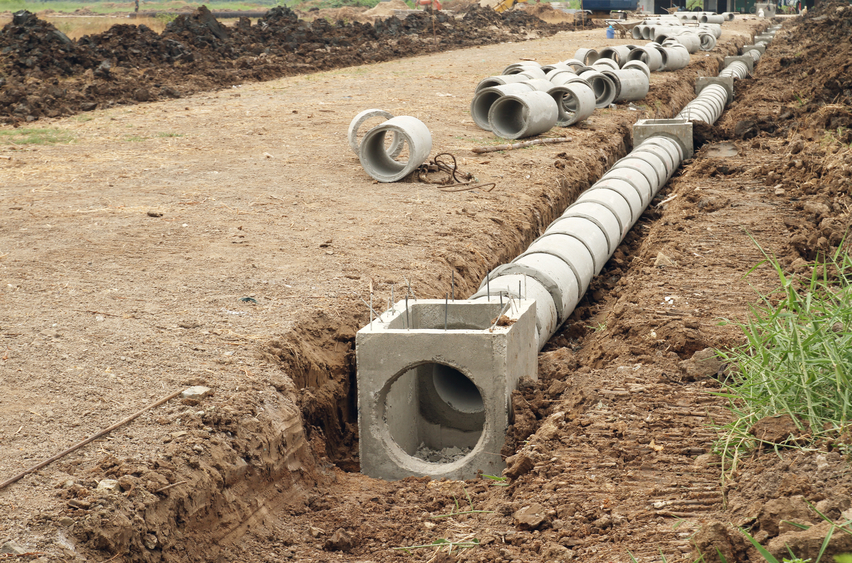Pavement Design 24 PDH Discount Package
Courses in this Package
An Introduction to Concrete Pavements (C06-009)
An Introduction to Flexible Pavement Design (C02-015)
An Introduction to Geotextiles in Pavement and Drainage Applications (C02-019)
An Introduction to Pavement Overlays (C02-046)
An Introduction to Railroad Trackage (C02-047)
An Introduction to Road Design for Cold Regions (C02-045)
An Introduction to Roller-Compacted Concrete Pavements (C03-036)
An Introduction to Soil Stabilization for Pavements (C03-028)
An Introduction to the Principles of Pavement Drainage (C02-048)

This online engineering PDH course provides information on the materials and construction procedures for portland cement concrete pavements. It describes the constituents to be used in concrete, the procedures to be used in manufacturing concrete, and the equipment and procedures to place, texture, and cure concrete for pavements. It is applicable to pavements for streets and roads, vehicle parking areas, and airfields.
This 6 PDH online course is intended for civil and structural engineers and other design and construction professionals seeking an introduction to the technologies, equipment and construction practices for portland cement concrete vehicular and airfield pavements.
This PE continuing education course is intended to provide you with the following specific knowledge and skills:
- Learning about responsibilities for mixture proportioning
- Learning how to prepare and test concrete samples for flexural strength
- Learning about the relationship between water-cement ratio and strength of concrete
- Learning how to determine the field control strength for concrete
- Understanding the importance of air entrainment in concrete
- Learning about the five principal types of concrete produced in the United States
- Learning about grading of coarse and fine aggregate
- Learning about deleterious materials in aggregate and why they must be controlled
- Learning about admixtures and how and when they are employed
- Learning about manufacturing, delivering and placing concrete
In this professional engineering CEU course, you need to review the course document titled, "An Introduction to Concrete Pavements".
Upon successful completion of the quiz, print your Certificate of Completion instantly. (Note: if you are paying by check or money order, you will be able to print it after we receive your payment.) For your convenience, we will also email it to you. Please note that you can log in to your account at any time to access and print your Certificate of Completion.

This online engineering PDH course provides an introduction to flexible pavement design. It is a basic treatment that will introduce designers to some important principles and terminology. In simple applications on real projects the information provided will give designers a good start in addressing subgrades, select materials and subbase courses, base courses and pavement design for flexible pavements for streets, roads and parking lots.
This 2 PDH online course is intended for engineers, architects and construction professionals who are interested in gaining a better understanding of flexible pavement design for streets, roads and parking areas. The course presents the basic terminology and technical considerations needed to help designers address flexible pavement design issues on specific projects.
This PE continuing education course is intended to provide you with the following specific knowledge and skills:
- Learn how to evaluate site and soil conditions.
- Learn about the California Bearing Ratio (CBR) and how it is used in pavement design.
- Learn how to evaluate traffic conditions and determine the Design Index.
- Learn how to design flexible pavement subgrades.
- Learn how to design flexible pavement select materials and subbase courses.
- Learn how to design flexible pavement base courses.
- Learn the design procedure for flexible pavement design.
In this professional engineering CEU course, you need to review the course document titled: "An Introduction to Flexible Pavement Design".
Upon successful completion of the quiz, print your Certificate of Completion instantly. (Note: if you are paying by check or money order, you will be able to print it after we receive your payment.) For your convenience, we will also email it to you. Please note that you can log in to your account at any time to access and print your Certificate of Completion.

This online engineering PDH course presents the different types of geotextiles including polypropylene, polyester, polyethylene, polyamide (nylon), polyvinylidene chloride, and fiberglass. It also discusses the physical properties of geotextiles as well as their design and construction methods, durability, functions, and applications with emphasis on two of their most important uses: applications in pavements and drainage design.
This 2 PDH online course is intended for engineers, designers and construction professionals who want to learn about the benefits and techniques for incorporating geotextiles into construction applications, including pavement and drainage structures.
This PE continuing education online is intended to provide you with the following specific knowledge and skills:
- Learning about the different types of geotextiles and how they are manufactured
- Learning the durability, functions and applications of geotextiles
- Learning about the use of geotextiles in pavement surface rehabilitation and reflective crack treatment
- Learning about how geotextiles are used for separation and reinforcement in pavement structures
- Learning the application of geotextiles in construction of drainage structures
- Learning the geotextile characteristics that influence drainage filter functions
In this professional engineering CEU course, you need to review the course document titled: "An Introduction to Geotextiles in Pavement and Drainage Applications".
Upon successful completion of the quiz, print your Certificate of Completion instantly. (Note: if you are paying by check or money order, you will be able to print it after we receive your payment.) For your convenience, we will also email it to you. Please note that you can log in to your account at any time to access and print your Certificate of Completion.

This online engineering PDH course provides an introduction to the selection, application and design of plain and reinforced portland cement concrete and asphalt concrete pavement overlays for streets, roads, parking and open storage areas.
Normally, overlays of existing pavements are used to increase the load-carrying capacity of an existing pavement or to correct a defective surface condition on the existing pavement. Of these reasons, the first requires a structural design procedure for determining the thickness of overlay; whereas the second requires only a thickness of overlay sufficient to correct the surface condition, and no increase in load-carrying capacity is considered.
The design method for overlays included in this course determines the thickness required to increase load-carrying capacity. These methods have been developed from a series of full-scale accelerated traffic tests on various types of overlays and are, therefore, empirical. These methods determine the required thickness of overlay that, when placed on the existing pavement, will be equivalent in performance to the required design thickness of a new pavement placed on subgrade.
This 2 PDH online course is intended for civil engineers and other design and construction professionals seeking to learn how to design and apply flexible and rigid overlays to existing flexible, composite and rigid pavements.
This PE continuing education course is intended to provide you with the following specific knowledge and skills:
- Understanding the measures necessary to prepare existing pavement for overlay
- Knowing the three bond conditions when overlaying a rigid pavement with a rigid overlay
- Learning about the condition rating factors "C" for existing pavements to be overlaid
- Learning how to calculate the thickness of rigid overlays for rigid pavements
- Learning how to design a rigid overlay of an existing flexible pavement
- Learning how to design overlays for composite pavements
- Learning how to apply overlays to flexible pavements
In this professional engineering CEU course, you need to review the course document titled, "An Introduction to Pavement Overlays".
Upon successful completion of the quiz, print your Certificate of Completion instantly. (Note: if you are paying by check or money order, you will be able to print it after we receive your payment.) For your convenience, we will also email it to you. Please note that you can log in to your account at any time to access and print your Certificate of Completion.

This online engineering PDH course provides an introduction to the design of railroad trackage in the United States. Included are roadways, ballast, ties, rails, track grade, turnouts, crossovers, highway crossings, sidings, warehouse trackage, track scales, and yards.
This 2 PDH online course is intended for engineers and other design and construction professionals seeking an introduction to the standards and practices for the design of running, siding and yard trackage for railroads in the United States.
This PE continuing education course is intended to provide you with the following specific knowledge and skills:
- Understanding the parameters for design of railroad trackage roadways
- Learning about the design and construction of trackage ballast and sub-ballast
- Learning about standardized track and tie configurations and materials
- Learning about the design considerations for running track alignment and grade
- Understanding the approach to design of highway grade crossings
- Learning about siding trackage
- Understanding the parameters for warehouse trackage
- Learning about track scales
In this professional engineering CEU course, you need to review the course document titled, "An Introduction to Railroad Trackage".
Upon successful completion of the quiz, print your Certificate of Completion instantly. (Note: if you are paying by check or money order, you will be able to print it after we receive your payment.) For your convenience, we will also email it to you. Please note that you can log in to your account at any time to access and print your Certificate of Completion.

This online engineering PDH course discusses roadway and runway design considerations for arctic and subarctic regions. It will introduce you to the design of subgrades, base courses and flexible and rigid pavements in these cold regions.
The construction of satisfactory roads and airfield runways in seasonal frost and permafrost areas is normally more difficult than in temperate regions because the imperviousness of the underlying permafrost tends to produce poor soil drainage conditions, and because disturbance of the natural surface may set in motion adjustments in thermal regime, drainage, and slope stability which may have serious and progressive consequences.
This 2 PDH online course is intended for civil and geotechnical engineers and other design and construction professionals seeking an introduction to materials and methods for design of roads and airfield runways in arctic and subarctic regions.
This PE continuing education course is intended to provide you with the following specific knowledge and skills:
- Learning about the soils where there is danger of loss in bearing capacity upon thawing, and of heaving action upon freezing
- Understanding the four classifications of soils in which ice segregation generally occurs when favorable ground water and freezing temperatures are present
- Learning how frost and permafrost conditions may be altered by changed surface conditions produced by construction
- Understanding how in areas of permafrost the location of the ground water surface is greatly influenced by the existence of the underlying impervious permafrost layer
- Making recommendations for base course and pavement composition in arctic and subarctic regions
- Learning about base course design in non-frost-susceptible soils
In this professional engineering CEU course, you need to review the course document titled, "An Introduction to Road Design for Cold Regions".
Upon successful completion of the quiz, print your Certificate of Completion instantly. (Note: if you are paying by check or money order, you will be able to print it after we receive your payment.) For your convenience, we will also email it to you. Please note that you can log in to your account at any time to access and print your Certificate of Completion.

This online engineering PDH course provides an introduction to the materials, methods, delivery and placement of roller-compacted portland cement concrete pavements. It describes procedures and criteria that are applicable to the design and construction of roller-compacted concrete pavements.
Roller-compacted concrete pavement (RCCP) employs a concrete paving technology that involves laydown and compaction of a zero-slump concrete mixture using equipment similar to that used in placement and compaction of asphaltic concrete pavement. By using these construction techniques, the potential exists to save one-third or more of the cost of conventional concrete pavement. Although the concept and technology behind RCCP is relatively new, RCCP has already proven itself cost-effective in projects including log-sorting yards, port facilities, heavy equipment parking areas, tank trails, and haul roads.
This 3 PDH online course is intended for civil and highway engineers and other design and construction professionals seeking an introduction to the technologies, equipment and construction practices for roller-compacted portland cement concrete pavements.
This PE continuing education course is intended to provide you with the following specific knowledge and skills:
- Learning about base and subgrade preparation
- Learning how to select pavement materials
- Learning about mixture proportioning
- Learning about pavement thickness design
- Learning about mixture proportioning, batching, mixing and transporting of materials
- Learning about pavement placing techniques and requirements
- Learning about compaction requirements
- Learning about cold joints, curing, and overall quality control
In this professional engineering CEU course, you need to review the course document titled, "An Introduction to Roller-Compacted Concrete Pavements".
Upon successful completion of the quiz, print your Certificate of Completion instantly. (Note: if you are paying by check or money order, you will be able to print it after we receive your payment.) For your convenience, we will also email it to you. Please note that you can log in to your account at any time to access and print your Certificate of Completion.

This online engineering PDH course will introduce you to accepted methods for stabilizing soils underlying new pavements to improve strength and durability. You will also learn about methods to achieve better soil gradation, and reduction of plasticity index or swelling potential. You will learn how it may be possible to reduce the thickness of soil layers by stabilization methods. The course covers stabilizers such as portland cement, lime, lime-fly ash, lime-cement-fly ash, bitumen, lime-cement and lime-asphalt. Stabilizer selection based on soil conditions is discussed, as well as special considerations in frost areas.
This 3 PDH online course is intended for civil engineers and construction professionals seeking an introduction to the materials and methods of soil stabilization for pavements.
This PE continuing education course is intended to provide you with the following specific knowledge and skills:
- Learning how to select additives based on soil types
- Learning how to use stabilized soils in frost areas
- Learning how base and subbase courses may be reduced using soil stabilization
- Learning how to determine stabilizer content
- Learning about portland cement as a stabilizer
- Learning about stabilization with lime
- Learning about stabilization with lime-fly ash and lime-cement-fly ash
- Learning about stabilization with bitumen
- Learning about lime-cement stabilization
- Learning about lime-bitumen stabilization
In this professional engineering CEU course, you need to review the course document titled, "An Introduction to Soil Stabilization for Pavements ".
Upon successful completion of the quiz, print your Certificate of Completion instantly. (Note: if you are paying by check or money order, you will be able to print it after we receive your payment.) For your convenience, we will also email it to you. Please note that you can log in to your account at any time to access and print your Certificate of Completion.

This online engineering PDH course provides an introduction to the terminology, fundamentals and methodologies for the design of drainage features in pavements.
Water has a detrimental effect on pavement performance, primarily by either weakening subsurface materials or erosion of material by free water movement. For flexible pavements, the weakening of the base, subbase or subgrade when saturated with water is one of the main causes of pavement failures. In rigid pavement, free water trapped between the rigid concrete surface and an impermeable layer directly beneath the concrete, moves due to pressure caused by loadings.
This movement of water (referred to as pumping) erodes the subsurface material creating voids under the concrete surface. In frost areas, subsurface water will contribute to frost damage by heaving during freezing and loss of subgrade support during thawing. Poor subsurface drainage can also contribute to secondary damage such as 'D' cracking or swelling of subsurface materials.
This 2 PDH online course is intended for civil engineers and other design and construction professionals wanting an introduction to the principles of pavement drainage.
This PE continuing education course is intended to provide you with the following specific knowledge and skills:
- Learning about the effects of subsurface water
- Learning about the effects of infiltration and subterranean water
- Understanding how subdrainage facilities can be categorized into two functional categories, one to control infiltration, and one to control groundwater
- Understanding how flow of water through soils is expressed by Darcy's empirical law
- Understanding how the value of permeability depends on the characteristics of the permeable materials and the properties of the fluid
- Understanding how permeability is a function of a complex relationship with grain size
- Learning about the void ratio or porosity of soils, and its influence on permeability
- Learning why the type and condition of the pavement surface will have considerable influence on the volume of water entering the pavement structure
- Learning about pavement drainage in frost susceptible soils
Upon successful completion of the quiz, print your Certificate of Completion instantly. (Note: if you are paying by check or money order, you will be able to print it after we receive your payment.) For your convenience, we will also email it to you. Please note that you can log in to your account at any time to access and print your Certificate of Completion.